Carolyn E. Furness, Friend of Yerkes
by Alexandra Masegian
Introduction
At a time when the work of women in astronomy was rarely recognized, Caroline E. Furness (1869–1936) refused to accept that her sex should limit her potential. “I only want to prepare myself for the highest place—just as any young man might,” she wrote to her father as a college senior in 1891.[1]
Despite her father’s misgivings, she pursued graduate study and became the first woman to earn a PhD in astronomy from Columbia University. She then went on to serve as the director of the Vassar College Observatory from 1910 until her death in 1936, where she conducted groundbreaking work on variable stars. [2]
During her time at Vassar, she corresponded frequently with Yerkes Observatory director Edwin B. Frost, who became both a respected collaborator and a dear friend. She wrote to Frost to recommend Vassar graduates for positions at Yerkes; to exchange scientific ideas and materials; and to provide solicited advice on Frost’s hiring decisions. In this way, Furness was directly responsible for the placement of multiple women into junior-level positions in astronomy, an effort that Frost was entirely willing to support.

Furness’s association with the University of Chicago began when she enrolled in the summer school of 1895 to study astronomy, as can be seen in this directory from the Quarterly Calendar. Just one year later, she would begin formal graduate study at Columbia University, where she eventually obtained her PhD. [3] Though Yerkes Observatory would not begin operation until October of 1897, construction on the observatory building and its flagship telescope had already begun under the guidance of Professor of Astronomy George Ellery Hale, who would serve as the director of Yerkes until 1903. [4] It is possible that he and Furness crossed paths during hersummer at the university.
Guiding Star: Furness as a Patron
At the time Furness was beginning her career, there were very few prominent woman astronomers. Most of the opportunities in astronomy open to women were restricted to the lowest levels of the academic ladder. Women’s colleges were the most notable exception, even though they only hired a small fraction of their own graduates. [5]
As the director of the Vassar College Observatory, home to one of the strongest programs in astronomy among the women’s colleges, Furness took a special interest in the mentoring of women astronomers. Her close relationship with Frost allowed her to directly recommend Vassar students for positions at Yerkes, which contributed significantly to increasing the number of women at the observatory.
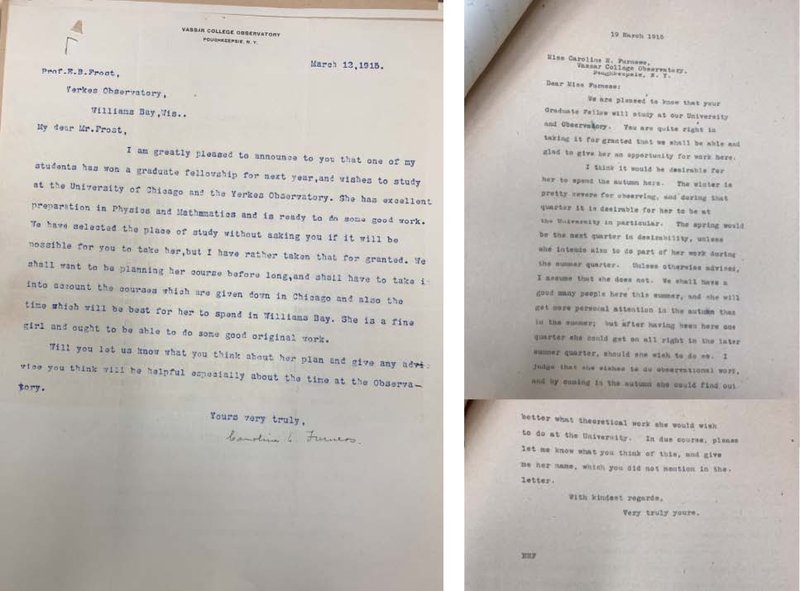
Furness frequently wrote to Frost to recommend exceptional Vassar graduates for positions at Yerkes. The letter shown here (Item A) stands out for its directness. By 1915, the two had been corresponding for over a decade and had established a close working relationship. Because of this, Furness felt comfortable assuming that Frost would accept her student without hesitation, especially when that student had secured an external fellowship and did not require Yerkes funding. As can be seen in Frost’s good-natured response (Item B), her assumption was correct. By making personal recommendations like this one, Furness secured positions at Yerkes for many women over the course of her career.
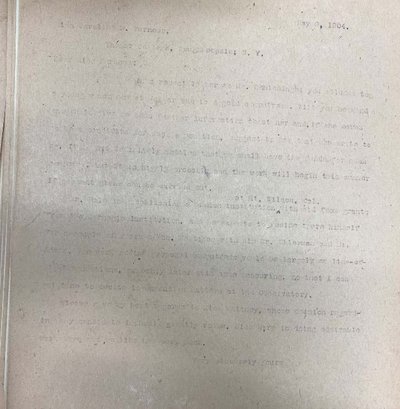
Partial transcription (low confidence):
May 9, 1904.
[UNKNOWN] Caroline E. Furness,
Vassar College, Poughkeepsie, N.Y.
Dear Miss Furness:
In a recent letter to Mr. [Schledinger] you alluded to a young woman now at Vassar who is a good computress. Will you be kind enough to give us [some] further information about her and, if she cares to be a candidate for such a position, suggest to her that she write to us.
[…]
Very sincerely yours
EBF
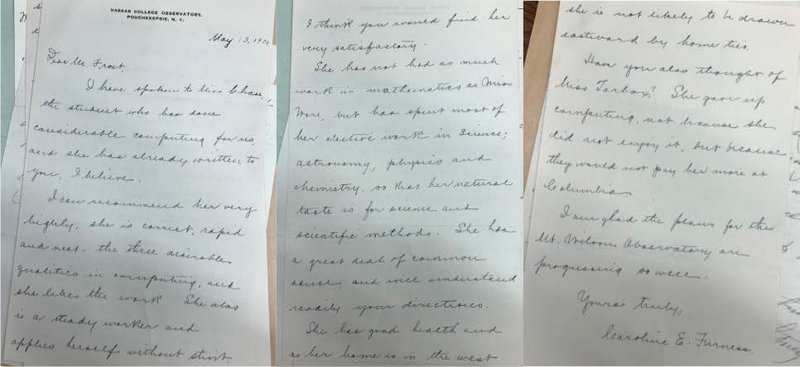
Transcription:
May 13, 1904
Dear Mr. Frost,
I have spoken to Miss Chase, the student who has done considerable computing for us, and she has already written to you, I believe. I can recommend her very highly, she is correct, rapid and neat – the three desirable qualities in computing, and she likes the work. She also is a steady worker and applies herself without [UNKNOWN]. I think you would find her very satisfactory.
She has not had as much work in mathematics as Miss Ware, but has spent most of her elective work in Science; astronomy, physics and chemistry, so that her natural taste is for science and scientific methods. She has a great deal of common sense and will understand readily your directions.
She has good health and as her home is in the west she is not likely to be drawn eastward by home ties. Have you also thought of Miss Tarbot? She gave up computing, not because she did not enjoy it, but because they would not pay her more at Columbia.
I am glad the plans for the Mt. Wilson Observatory are progressing so well.
Yours truly,
Caroline E. Furness
Frost frequently solicited recommendations from Furness to fill open positions at Yerkes. In this letter from May of 1904 (Item A), he asks Furness to put him in touch with a promising candidate that she had mentioned at an earlier date, Miss Chase. Furness wrote back just a few days later both highly recommending Miss Chase and suggesting second candidate, Miss Tarbot, for Frost to consider (Item B). This exchange demonstrates that Frost actively sought to recruit women to positions at Yerkes. In order to recruit most effectively, he relied on Furness to help him find strong candidates, a testimony to the strength of their friendship.
Knowledge Transfer: Furness as a Collaborator
Furness’s close relationship with Frost fostered a strong scientific collaboration between Vassar and Yerkes. During the summer months, Furness visited Yerkes to conduct research, attend scientific meetings, and see friends in the area. She and Frost often consulted each other on the latest advancements in astronomy research as well as their own ongoing projects.
As was the case at most women’s colleges, Vassar only had limited resources to devote to the astronomy program. Furness’s relationship with Frost was vital in facilitating the expansion of astronomical research at Vassar. By becoming Frost’s collaborator as well as his friend, Furness was able to gain access to Yerkes’s wealth of resources and pass those resources on to her students.
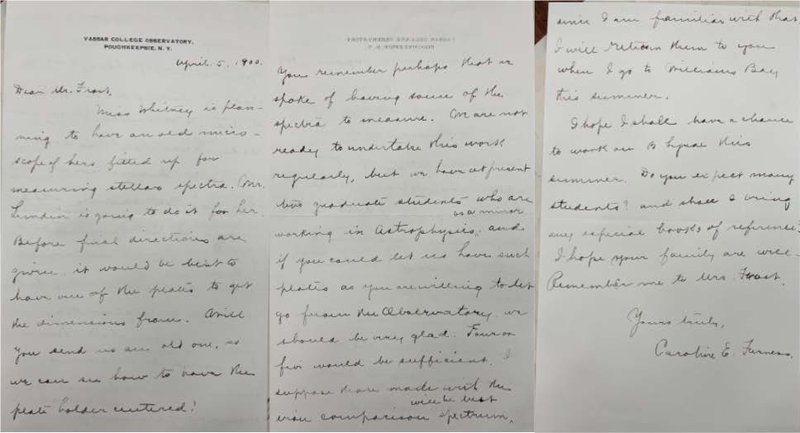
Transcription:
Vassar College Observatory
Poughkeepsie, N.Y.
April 5, 1900
Dear Mr. Frost,
Miss Whitney is planning to have an old microscope of hers fitted up for measuring stellar spectra. Mr. [Lundin] is going to do it for her. Before final directions are given, it would be best to have one of the plates to get the dimensions from. Will you send us an old one, so we can see how to have the plate holder centered?
You remember perhaps that we spoke of having some of the spectra to measure. We are not ready to undertake this work regularly, but we have at present two graduate students who are working in Astrophysics as a minor and if you could let us have such plates as you are willing to let go from the Observatory, we should be very glad. Four or five would be sufficient. I suppose those made with the [UNKNOWN] comparison spectrum will be best since I am familiar with that. I will return them to you when I go to Williams Bay this summer.
I hope I shall have a chance to work on B Lyrae this summer. Do you expect many students? and shall I bring any special books of reference?
I hope your family are well – Remember me to Mrs. Frost.
Yours truly,
Caroline E. Furness
Furness and Frost frequently exchanged scientific ideas and materials between Vassar and Yerkes. In this letter from April 1900, Furness requests that Frost send her a few spectroscopic plates taken at Yerkes for her students to analyze and learn from. Given the limited observational resources at Vassar, Furness’s close relationship with Frost was beneficial because it allowed her to draw on the resources at Yerkes for her teaching and research. Frost, who quickly sent the plates she asked for, was more than happy to support her.
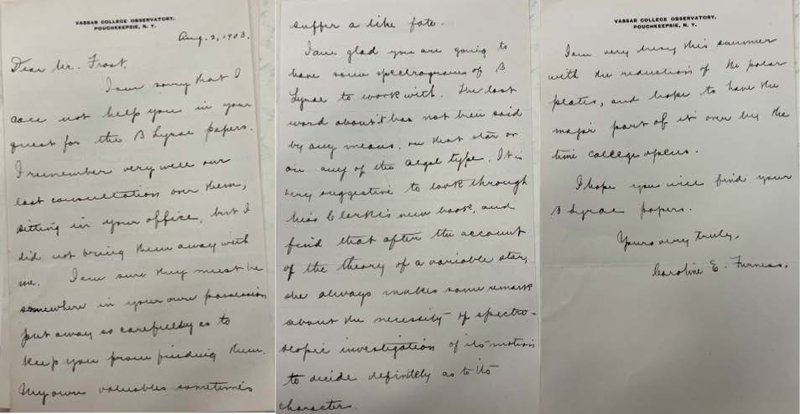
Transcription:
Vassar College Observatory
Poughkeepsie, N.Y.
Aug. 2, 1903
Dear Mr. Frost,
I am sorry that I can not help you in your quest for the B Lyrae papers. I remember very well our last conversation over them, sitting in your office, but I did not bring them away with me. I am sure they must be somewhere in your own possession put away so carefully as to keep you from finding them. My own valuables sometimes suffer a like fate.
I am glad you are going to have [some spectrograms] of B Lyrae to work with. The last word about it has not been said by any means, over that star or over any of the Algol type. It is very suggestive to look through Miss [UNKNOWN] new book, and find that after the account of the theory of a variable star, she always makes some remarks about the necessity of spectroscopic investigation of its motion to decide definitively as to its character.
I am very busy this summer with the reduction of the polar plates, and hope to have the major part of it over by the time college opens.
I hope you will find your B Lyrae papers.
Yours very truly,
Caroline E. Furness
In addition to being friends, Furness and Frost were also scientific collaborators. In this letter from 1903, Furness references their ongoing conversations about the variable star B Lyrae, which they studied together when Furness visited Yerkes during the summer. She also provides a brief update on her own research and her plans for the summer, suggesting that she and Frost frequently discussed their research outside of the context of projects they were collaborating on directly. Moreover, it appears that Frost actively sought her opinion on research-related questions, indicating that he saw her as an equal in terms of research ability.
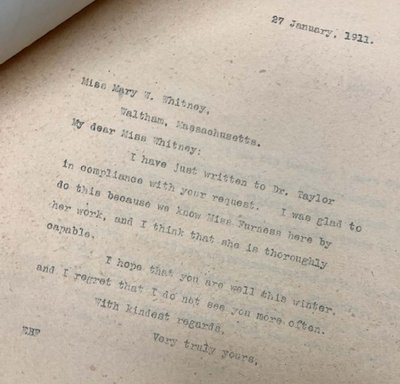
In 1911, Mary Watson Whitney, then the director of the Vassar astronomy program, [6] wrote to Frost to request a recommendation letter for Furness, who was up for promotion. Frost’s response to Whitney offers direct insight into his opinion of Furness as a person and an astronomer. In Frost’s eyes, Furness is “thoroughly capable,” especially because she has produced work that is well-known at Yerkes. In a time where the work of woman astronomers was often overlooked and undervalued, Frost’s high opinion of Furness suggests an openmindedness that was rare among his peers. His willingness to support her also illustrates their close friendship.
Notes
[1] John Lankford and Rickey L. Slavings, “Gender and Science: Women in American Astronomy, 1859-1940,” Physics Today 43, no. 3 (1990): 65.
[2] “Caroline E. Furness '1891.” Vassar Encyclopedia, 2008. https://vcencyclopedia.vassar.edu/distinguishedalumni/caroline-e-furness/.
[3] “Caroline E. Furness '1891.” Vassar Encyclopedia, 2008. https://vcencyclopedia.vassar.edu/distinguishedalumni/caroline-e-furness/.
[4] Steele, Diana. “Yerkes Observatory: A Century of Stellar Science.” The University of Chicago Chronicle, March 20, 1997. Accessed via http://chronicle.uchicago.edu/970320/yerkes.shtml.
[5] Pamela E. Mack, “Straying from Their Orbits: Women in Astronomy in America,” in Women of Science: Righting the Record, G. Kass Simon and Patricia A. Farnes eds. (Bloomington: Indiana University Press, 1990), 72–116.
[6 ]“Mary Watson Whitney '1868, ' 1872.” Vassar Encyclopedia, 2008.
https://vcencyclopedia.vassar.edu/distinguished-alumni/mary-watson-whitney/.